#doreen rappaport
Explore tagged Tumblr posts
Text
Civil Rights and adventure travel (for kids)
One thing I should say about this blog: if anyone reading it in the future needs to know the suitability of a book for a certain age, you'll have to follow my links to another site - I'm not qualified to judge, and I don't have children of my own, so dig deeper if you want to know if a book I recommend is appropriate for a specific kid or classroom.
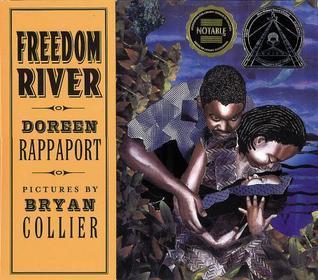
My first two books today were clearly returned by someone teaching her children about civil rights. Doreen Rappaport's Freedom River, tells a story about crossing the Ohio River from the slave-owning states of Kentucky or West Virginia to the free state of Ohio. Surprisingly action-packed for a kid's book, the narrative keeps the reader in suspense until the end. The art, however, puts this one over the top. I would call the style "quilting with paper" - but collage pretty well covers it. The colors, patterns and textures create motion and a 3d effect that had me running my fingers over the pages. Absolutely gorgeous work in this one.
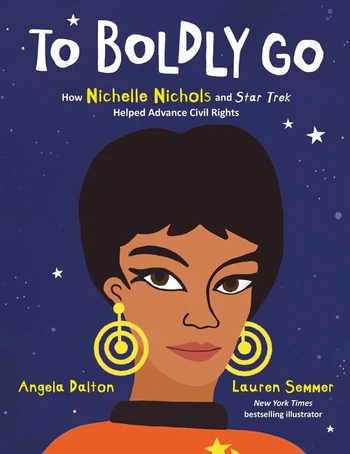
A very different style of art, simple, bright and almost cartoonish, supports the story of To Boldly Go: How Nichelle Nichols and Star Trek Helped Advance Civil Rights. The narrative is twofold: a young narrator speaks of the thrill of watching Nichols on screen as a child with her family, and then a 3rd person narrative takes over with a biography of Nichols. I have heard and read Nichols' story before, and I particularly love the part where Martin Luther King, Jr. himself tells her not to quit the show, reminding her of how important it is for people to see her onscreen as an equal member of the crew. I'm glad Angela Dalton thought this story worthy of her efforts. She treats it lightly, not slowing the story down with too much detail, but the impact remains significant.
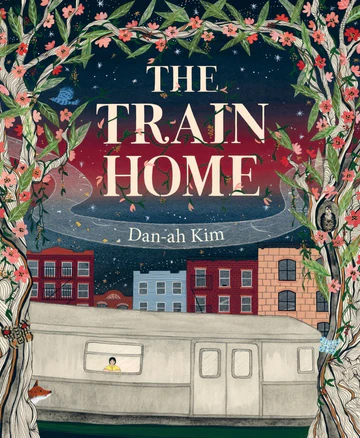
I really enjoy the way artists can "texture" children's books. Dan-ah Kim's lush The Train Home is like the above-mentioned Freedom River, composed of pen and ink drawing, cut paper and fabric. Again I find myself running my fingers over the page to feel the composition of the art. In the story, Nari looks out of her apartment window, annoyed by the noisiness of her environment, and, as the train rumbles by, she imagines where it might take her, away from city noise. In the forest, she imagines herself in a nest, surrounded by bleeding hearts, butterflies and blue jays. She imagines herself under the sea, living with mermaids and a newspaper-reading, spectacle-wearing octopus. The colors leap off the page as she moves from one potential home to another (what is it about marble lions and libraries?), eventually deciding that she wouldn't be happy without her sister's songs, her grandparents' stories and her parents' laughter. A stunning piece of artwork and a great nudge to children's imagination.
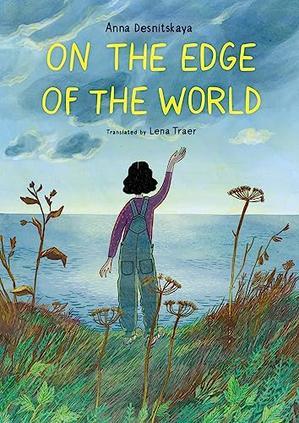
Last but not least is Anna Desnitskaya's On the Edge of the World. It piqued my curiosity because the cover (image, author, title of book) is on both sides of the book - one the reverse of the other. I started with Lucas's side, which tells of his life "on the edge of the world" in Southern Chile, where his father is a marine biologist. Desnitskaya interrupts the narrative with funny pages sketching Lucas's favorite things, illustrated maps and definitions, then returns to the narrative, where Vera begins appearing, as a ghost (outlined), as Lucas wishes he had a friend. He sends a signal in Morse code with his flashlight out into the darkness over the sea...at which point the reader must flip the book upside down and begin to read Vera's story. She lives on the Kamchatka Peninsula in North-Eastern Russia, and she also longs for a friend. It's a very clever and creative way to tell a story - my only complaint is that it's unsatisfying: Lucas and Vera never actually connect - Desnitskaya just leaves it as a possibility. The book has other virtues, however - teaching geography, local flora and fauna, and Morse code. I loved that Lucas climbed a tree to read a new book - and quoted the first lines of The Lion, the Witch and the Wardrobe. Then, when we read Vera's story, we find that LWW is her favorite book. She, in turn, refers to The Hobbit (Lucas's favorite book) - great teasers for readers inclined to adventure. Even cooler, when I looked it up, I found that this one has been translated from Russian.
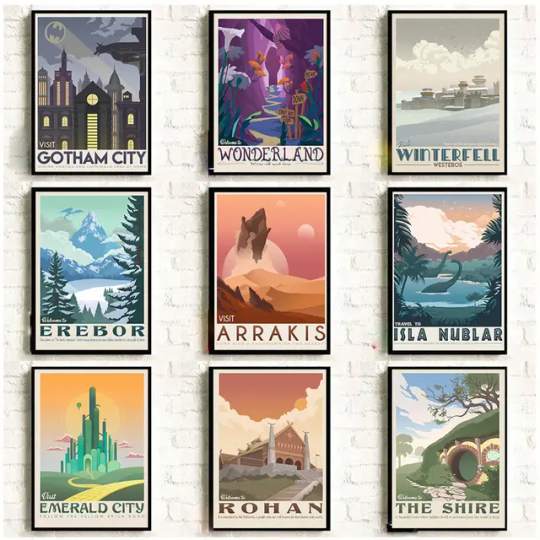
I read an article today detailing how one librarian teaches digital literacy; more on this in a future blog, I hope. In the background of a picture of her, I saw delightful "vintage", "travel" posters to Narnia and the Shire and Arrakis. Someday, if I become a children's librarian, I'd love to do something travel-related with this: decorate with such posters, design maps, plan brochures, travel agents... I suppose librarians don't usually do projects with teenagers, but if I could start a reading club, maybe kids would find the enthusiasm for their books enough to do projects - especially if it took place over the summer.
#freedom river#the train home#to boldly go: how nichelle nichols and star trek helped advance civil rights#on the edge of the world#civil rights books for children#traveling through reading#art of children's books#doreen rappaport#angela dalton#anna desnitskaya#dan-ah kim#chile#kamchatka peninsula#nichelle nichols#star trek
0 notes
Text

“Lady Liberty: Candlewick Biographies by Doreen Rappaport: 9780763671143 | PenguinRandomHouse.com: Books.” PenguinRandomhouse.com, www.penguinrandomhouse.com/books/139204/lady-liberty-candlewick-biographies-by-doreen-rappaport-illustrated-by-matt-tavares/9780763653019?ref=PRH8078BD739C&aid=35511&linkid=PRH8078BD739C. Accessed 20 Feb. 2023.
0 notes
Text

BHM Book of the Day
“Martin’s Big Words: The Life of Dr. Martin Luther King, Jr.” by Doreen Rappaport
#martins big words#martin luther king jr#godzilla reads#doreen rappaport#bhm book of the day#bhm botd#bhm#botd#book of the day#black history#black history month#black literature#black lives matter#blm#black leaders#civil rights movement#books#books and literature#books and reading#book blog#book blurb#bookworm#booklover#booklife#book addict#book aesthetic#bibliophile#booknerd#bookish#childrens literature
17 notes
·
View notes
Photo
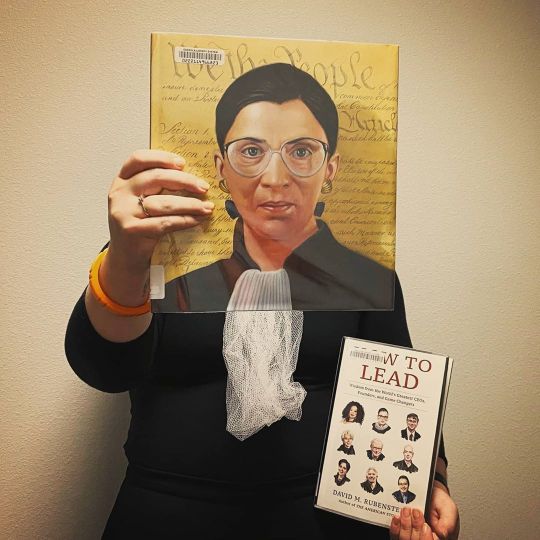
Keep her memory standing. RUTH OBJECTS: THE LIFE OF RUTH BADER GINSBURG by Doreen Rappaport. #olsbookface Also pictured: HOW TO LEAD by David M. Rubenstein #bookfacefriday #osceolalibrary #librarybooks #librarystaff #ruthbaderginsburg #RBG #RIPRBG #RIP #restinpower #restinpeace #doreenrappaport #ruthobjects #howtolead #davidmrubenstein https://www.instagram.com/p/CFkB572hQu2/?igshid=d1lco5z9zjlk
#olsbookface#bookfacefriday#osceolalibrary#librarybooks#librarystaff#ruthbaderginsburg#rbg#riprbg#rip#restinpower#restinpeace#doreenrappaport#ruthobjects#howtolead#davidmrubenstein
5 notes
·
View notes
Link
children's short stories audiobooks : 42 is Not Just a Number by Doreen Rappaport | Kids
Listen to 42 is Not Just a Number new releases children's short stories audiobooks on your iPhone, iPad, or Android. Get any BOOKS AUDIO by Doreen Rappaport Kids FREE during your Free Trial
Written By: Doreen Rappaport Narrated By: Doreen Rappaport, JD Jackson Publisher: Brilliance Audio Date: September 2017 Duration: 2 hours 10 minutes
#42 is Not Just a Number#42 is Not Just a Number Audiobook#Audiobook#Kids#Doreen Rappaport#JD Jackson#September 2017
0 notes
Quote
There are many times in my life, on a personal or political level, when I have been discouraged that progress for women and minorities is just too slow, and then I remember Elizabeth Cady Stanton and Susan B. Anthony and all the other trailblazing women who had the vision and dream that they could change life for women. They persisted and persisted for 82 years, despite being humiliated and belittled, because they understood that "Failure is impossible." These women inspire me when I am faced with seeming dead ends in my life. I hope they will inspire you.
Doreen Rappaport, author of Elizabeth Started All the Trouble (Disney-Hyperion, 2016), a 2017 Amelia Bloomer List selection

The Amelia Bloomer List is a project of the American Library Association’s Feminist Task Force. To learn more about the Amelia Bloomer Project, you can visit our blog.
0 notes
Text
Heroes Slipping Away
Slowly, they’re all slipping away. I noted with interest and with regret the death the other day at age 112 of Richard Overton, the oldest living American veteran of World War II. He had an amazing story, actually: the grandson of slaves from Tennessee who grew up in Texas suffering the petty indignities routinely visited upon black people in the South during the first decades of the twentieth century, he was present at Pearl Harbor, Okinawa, and Iwo Jima and so personally witnessed some of the most important events that took place in the Pacific theater of war and lived to tell the tale. There’s something very compelling to me in that story, something suggestive of the kind of heroic patriotism that would lead a man to volunteer for military service in the defense of his nation even despite the degree to which he personally had suffered from the racism that was at that time an endemic part of life for black Americans, and particularly in the South. For more about his life, click here.

Almost twenty years Richard Overton’s junior, Simcha Rotem also died last week. Rotem, born Szymon Ratajzer and known by the nom-de-guerre Kazik when he participated in the Warsaw Ghetto uprising in the spring of 1943, was its last living survivor. The Warsaw Ghetto uprising was so deeply engrained in my consciousness when I was a child that it’s almost surprising to me to recall that I was born a decade after it was brutally and decisively put down by Poland’s German occupiers. It was the sole example my father would bring up again and again as proof positive that the Jews of Europe did not just go to the slaughter like sheep in an abattoir, and I must have heard at least some of the stories connected with the uprising hundreds of times. As a result, Leon Uris’s book, Mila 18, was the first full-length novel I read about the Shoah—before, even, I read The Last of the Just—and is in some ways the literary foundation stone upon which rests my sense of myself as some kind of survivor after-the-fact: my father’s people came from a small town just outside Warsaw called Nowy Dwor and met the exact same fate as the Jews of nearby Warsaw. Published when I was eight years old, Mila 18 was only a former bestseller by the time I got to it. But that didn’t matter to me at all, as neither have done the various accounts published more recently documenting resistance by Jewish communities and individuals throughout occupied Europe—effectively putting to rest my father’s sense that Warsaw was our single effort, quixotic at best but more than real, to defy the Germans and prevent our own annihilation: none has meaningfully diminished the place the Warsaw Uprising occupies in my own Jewish consciousness. (For more on Jewish resistance during the Shoah, I recommend Doreen Rappaport’s book, Beyond Courage: The Untold Story of Jewish Resistance During the Holocaust, published in 2012 and still widely available.) In the world of my childhood, Mordechai Anielewicz, the leader of the Jewish Fighting Organization who served as the leader of the uprising and who died at Mila 18 at age twenty-four, was the hero of all heroes.
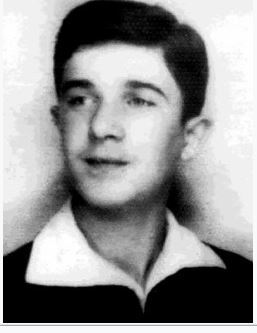
To say that the uprising was a failure is almost to say nothing at all. German losses were seventeen dead (all but one killed in action) and ninety-three injured (including sixty members of the SS). Jewish losses were on a different scale entirely and were staggering: 13,000 killed in the course of the uprising and the remaining 56,000 residents of the ghetto deported immediately to Treblinka or Majdanek and murdered in those places upon arrival.
Just a few days before the uprising was decisively ended by German forces, there was a successful attempt to rescue some few of the Ghetto’s defenders. That this was attempted at all is amazing enough, but more amazing still is that the operation was successful and allowed many of the escapees to carry the struggle forward, adopting the techniques of guerilla warfare to harass and occasionally kill German soldiers and eventually joining forces with the Poles who launched the “other” Warsaw Uprising in the summer of 1944. And one of the organizers of this almost miraculous flight from certain death was Simcha Rotem, called Kazik, who died last week and was the last survivor of the fighters who participated in the uprising.
Kazik was a boy of eighteen in 1942. He was already a survivor, though, even then: several family members and his brother were killed when a German bomb fell on his family’s home a few years earlier. There are other names to mention as well. Mordechai Anielewicz was the commander of the Jewish Fighting Force inside the ghetto, for example, but there was also Yitzchak Zuckerman serving as the organization’s commander on the Gentile side of the barrier that defined the ghetto. And, in fact, it was as courier between Anielewicz and Zuckerman that Kazik made his greatest and more daring contribution to the effort to resist the German effort to kill every Jew in Poland. His adventures are both terrifying and remarkable to relate. He was stuck for a while on the Gentile side and had to try repeatedly to re-enter the ghetto. Eventually, he succeeded by wading through the sewers that even the Germans couldn’t figure out how to close. And then his moment of true greatness came as the final destruction of the ghetto was almost upon them all, and he was able—because he was so familiar with the Warsaw sewer system—to bring Zivia Lubetkin, one of the last surviving leaders of the uprising, and about eighty others to safety first in Gentile Warsaw and then, soon after that, in the forests surrounding the city. He himself spent the rest of the war helping Jews in hiding and then eventually participating in the Warsaw Uprising of 1944. And then, after the war, he devoted himself to service on two different fronts: one, as a member of Nakam, the group devoted to exacting extra-legal vengeance on surviving Nazi war criminals, and the other as a member of Bricha, the group devoted to helping Jews immigrate to Mandatory Palestine despite the best efforts of the British to keep Jews out of their own homeland even after the Shoah deprived them of any other place to call home.
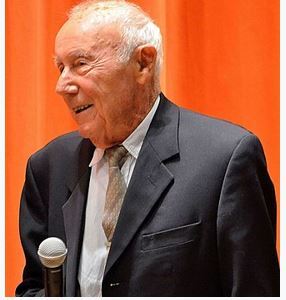
Although Kazik—who as Simcha Rotem ended up, of all things, as the manager of an Israeli supermarket chain until his retirement in 1986—was the sole remaining fighter when he died, there is still one single person left alive who was a child in the Warsaw Ghetto for as long as it existed: Aliza Vitis-Shomron was twelve years old in 1942 and somehow managed to survive after helping the cause along by distributing various kinds of leaflets in the ghetto before finally managing to escape.
When I was a boy growing up in Forest Hills, the survivor community was entirely different than it is today. For one thing, the survivors I knew as a boy were all young people—the parents, not the grandparents or great-grandparents, of my friends from elementary school. The word “survivor” itself was not in use back then, however, and I don’t believe I can recall any of my friend’s European parents using that word ever to describe themselves. They were far too interested in moving forward, in establishing a foothold in America, in learning to speak unaccented American English (a challenge successfully met only by some), in relegating the horrors of their own past to the swirling mists of history and living in the clear light of a safe, secure present. That people didn’t wish to speak about the past was a given in most households. I accepted that back then, never finding the nerve to ask even people I knew well about their personal stories. Almost the people in that category that I remember from my childhood are gone from the world now, though, and, although some contributed videotaped interviews to the Spielberg Holocaust Archive, most took their stories with them when they departed this world.
But at least I knew these people personally, whereas the great challenge in the future is going to be finding a way to raise up a new generation whose contact with Shoah survivors will either be minimal or non-existent. It’s already too late to meet anyone who belonged to the Jewish Fighting Organization in the Warsaw Ghetto Uprising, just as it is also impossible now to meet an American veteran who fought in the First World War. (The last living person to have served in the Allied Armed Forces died last November at age 110.) This happens, of course, to all historical events: the last living veteran of the Union Army who saw combat in the Civil War, James Hard, died in 1953…yet the Civil War is not only remembered by historians but remains completely alive in our national consciousness as one of the defining events in the history of the republic. Can we do the same for the Shoah as the survivors—and particularly people like Simcha Rotem who were eye-witnesses to events like the Warsaw Ghetto Uprising—fade from the scene? That is the question that Rotem’s death challenged me to ask and which I invite you all to join me in the wake of his passing now also to ponder.
#Simchah Rotem#Richard Overton#Mordechai Anielewicz#Warsaw Ghetto Uprising#Warsaw Uprising#Holocaust
22 notes
·
View notes
Text
Addams Author Eloise Greenfied is 2018 Coretta Scott King-Virginia Hamilton Award #JACBA Newsletter 23Feb2018
The Coretta Scott King Book Awards

Eloise Greenfield is the recipient of the 2018 Coretta Scott King-Virginia Hamilton Award for Lifetime Achievement.
"Eloise Greenfield is a trailblazer whose extraordinary books of poetry and prose have influenced many and continue to resonate with children today. Her rich body of work inspires and enriches readers," said Award Committee Chair Deborah D. Taylor.
Read More
Paul Robeson by Eloise Greenfield 1976 Awardee
UC San Diego exhibition features work by 7 leading international women
The seven artists - Eleanor Antin, Barbara Kruger, Faith Ringgold, Martha Rosler, Miriam ... Substantiate Our Horror" (1985), Faith Ringgold's hand-stenciled quilt "Seven Passages to a Flight"...

Presented together for the first time, seven internationally recognized artists are featured in the UC San Diego exhibition "Stories That We Tell: Art and Identity," celebrating those who paved the way for greater inclusion by inventing new means to address issues of race and gender.
The seven artists - Eleanor Antin, Barbara Kruger, Faith Ringgold, Martha Rosler, Miriam Schapiro, Lorna Simpson and Carrie Mae Weems - have all been honored with major exhibitions at leading museums, recognized with prestigious awards and are all representative of the university's Department of Visual Arts.
Read More
"Faith Ringgold: An American Artist" to open at the Crocker Art Museum

"In the exhibition Faith Ringgold: An American Artist, there is warmth, charm, and straightforward honesty in Ringgold's art," said Crocker Art Museum Associate Curator Kristina Gilmore. "It draws us in and disarms us, then often reveals powerful messages. Through her work, she speaks truths that are sometimes haunting and painful, but often joyful and heartwarming. It's quite inspirational."
Read More
Aunt Harriet's Underground Railroad in the Sky by Faith Ringgold 1993 Awardee
Exploring the Black Experience through the Art

"Create Dangerously - In this deeply personal book, the celebrated Haitian-American writer Edwidge Danticat reflects on art and exile, examining what it means to be an immigrant artist from a…
In this deeply personal book, the celebrated Haitian-American writer Edwidge Danticat reflects on art and exile, examining what it means to be an immigrant artist from a country in crisis. Inspired by Albert Camus' lecture, "Create Dangerously," and combining memoir and essay, Danticat tells the stories of artists, including herself, who create despite, or because of, the horrors that drove them from their homelands and that continue to haunt them. Danticat also suggests that the aftermaths of natural disasters in Haiti and the United States reveal that the countries are not as different as many Americans might like to believe.
Create Dangerously is an eloquent and moving expression of Danticat's belief that immigrant artists are obliged to bear witness when their countries of origin are suffering from violence, oppression, poverty, and tragedy.
Read More
Mama's Nightingale: A Story of Immigration and Separation written by Edwidge Danticat, illustrated by Leslie Staub 2016 Awardee
African-American history for young readers
Children's books on African-American history, they both said, are increasingly becoming part of mainstream curriculums.

"Just look at the American classrooms today," Andrea explained. "The majority have children of all kinds of races, nationalities and backgrounds. I think teachers and educators are realizing they have to serve these kids. These are the thought leaders, the teachers, the librarians, the illustrators, the writers and the decision makers of tomorrow."
Read More
Sit-In: How Four Friends Stood Up by Sitting Down by Andrea Davis Pinkney, illustrated by Brian Pinkney 2011 Awardee
Sojourner Truth's Step-Stomp Stride, by Andrea Davis Pinkney & Brian Pinkney 2010 Awardee
Top 10 Diverse Nonfiction for Older and Middle Readers

"Danza! Amalia Hernandez and Ballet Folklorico de Mexico. By Duncan Tonatiuh. Illus. by the author. 2017. Abrams, (9781419725326). Gr. 2–4. The life and work of dancer and choreographer Amalia Hernandez...
Read More
Separate is Never Equal: Sylvia Mendez and her family's fight for desegregation, written and illustrated by Duncan Tonatiuh 2015 Awardee
Black Power: 17 Children's Books on Black Activists, Innovators, and...

Schomburg, The Man Who Built a Library by Carole Boston Weatherford, illustrated by Eric Velasquez. Where is our historian to give us our side? Arturo asked.
The Legendary Miss Lena Horne by Carole Boston Weatherford, illustrated by Elizabeth Zunon: Celebrate the life of Lena Horne, the pioneering African American actress and civil rights activist.
Radiant Child, The Story of Young Artist Jean-Michel Basquiat by Javaka Steptoe: Jean-Michel Basquiat and his unique, collage-style paintings rocketed to fame in the 1980s as a cultural phenomenon unlike anything the art world had ever seen.
The Book Itch: Freedom, Truth & Harlem's Greatest Bookstore by Vaunda Micheaux Nelson, illustrated by R. Gregory Christie: In the 1930s, Lewis's dad, Lewis Michaux Sr., started a bookstore in Harlem and named it the National Memorial African Bookstore.
Gordon Parks: How the Photographer Captured Black and White America by Carole Boston Weatherford, illustrated by Jamey Christoph: His white teacher tells her all-Black class, You'll all wind up porters and waiters. What did she know? Gordon Parks is most famous for being the first Black director in Hollywood.
Frederick Douglass, The Lion Who Wrote History by Walter Dean Myers, illustrated by Floyd Cooper: Frederick Douglass was a self-educated slave in the South who grew up to become an icon.
Sugar Hill, Harlem's Historic Neighborhood by Carole Boston Weatherford, illustrated by R. Gregory Christie: Take a walk through Harlem's Sugar Hill and meet all the amazing people who made this neighborhood legendary. Includes brief biographies of jazz greats Duke Ellington, Count Basie, Sonny Rollins, and Miles Davis; artists Aaron Douglas and Faith Ringgold; entertainers Lena Horne and the Nicholas Brothers; writer Zora Neale Hurston; civil rights leader W. E. B. DuBois and lawyer Thurgood Marshall.
Coretta Scott by Ntozake Shange, illustrated by Kadir Nelson: Walking many miles to school in the dusty road, young Coretta Scott knew the unfairness of life in the segregated south.
Read More
Birmingham, 1963 by Carole Boston Weatherford 2008 Awardee
New Shoes by Susan Lynn Meyer, illustrated by Eric Velasquez 2016 Awardee
Hot Day on Abbott Avenue by Karen English, with collage art of Javaka Steptoe 2005 Awardee
Now Is Your Time! The African-American Struggle for Freedom by Walter Dean Myers 1992 Awardee
Patrol: An American Soldier in Vietnam by Walter Dean Myers 2003 Awardee
Ruth and the Green Book by Calvin Alexander Ramsey with Gwen Strauss and illustrated by Floyd Cooper 2011 Awardee
Heart and Soul: The Story of America and African Americans written and illustrated by Kadir Nelson 2012 Awardee
The Village That Vanished written by Ann Grifalconi and illustrated by Kadir Nelson 2003 Awardee
The Book Itch: Freedom, Truth & Harlem's Greatest Bookstore by Vaunda Micheaux Nelson, illustrated by R. Gregory Christie 2016 Awardee
Books help build strong girls
"I Dissent: Ruth Bader Ginsberg Makes Her Mark" by Debbie Levy. (Ages 4-8) This biographical picture book about the notorious Supreme Court justice, tells her story through her famous dissents, or disagreements.

"The Firefly Letters: A Suffragette's Journey to Cuba" by Margarita Engle. The award-winning poet paints a portrait of early women's rights pioneer Fredrika Bremer and the journey that transformed her life.
Read More
I Dissent: Ruth Bader Ginsburg Makes Her Mark, written by Debbie Levy, illustrated by Elizabeth Baddeley, 2017 Awardee
Silver People: Voices from the Panama Canal by Margarita Engle 2015 Awardee
The Surrender Tree: Poems of Cuba's Struggle for Freedom by Margarita Engle 2009 Awardee
9 Children's Books to Raise Awareness of Civil Rights
The Youngest Marcher: The Story of Audrey Faye Hendricks, A Young Civil Rights Activist by Cynthia Levinson

We Shall Overcome: The Story of a Song by Debbie Levy

Martin's Big Words: The Life of Dr. Martin Luther King, Jr. by Doreen Rappaport
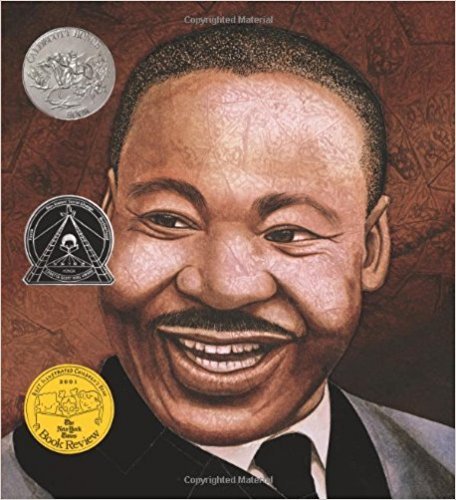
Through My Eyes by Ruby Bridges
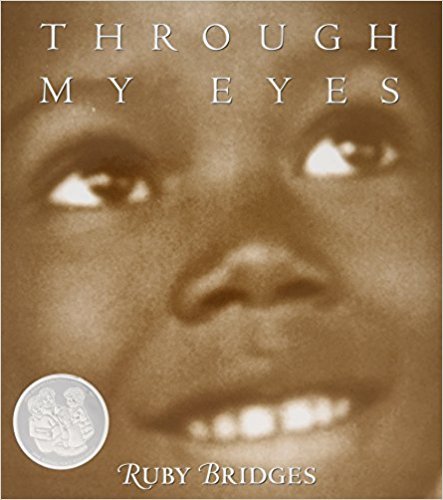
Brown Girl Dreaming by Jacqueline Woodson

...
Read More
We've Got a Job: The 1963 Birmingham Children's March by Cynthia Levinson 2013 Awardee
Martin's Big Words: The Life of Dr. Martin Luther King, Jr. written by Doreen Rappaport with artwork by Bryan Collier 2002 Awardee
Trouble at the Mines by Doreen Rappaport 1988 Awardee
Through My Eyes by Ruby Bridges 2000 Awardee
Each Kindness written by Jacqueline Woodson, illustrated by E.B. Lewis 2013 Awardee
From the Notebooks of Melanin Sun by Jacqueline Woodson 1996 Awardee
I Hadn't Meant to Tell You This by Jacqueline Woodson 1995 Awardee
---
The Jane Addams Children's Book Award annually recognizes children's books of literary and aesthetic excellence that effectively engage children in thinking about peace, social justice, global community, and equity for all people.
Read more about the 2017 Awards.
1 note
·
View note
Photo

On #mlkday, here’s one of our favorite books for ANY day. #martinsbigwords by Doreen Rappaport. #childrensbookswelove #mlk #mlkquotes #mlk #childrensliteracy #momlife #momlifeisthebestlife #parenting #parentingtips #momsofinstagram #instamoms @disneybooks @scholasticinc https://www.instagram.com/p/B7jJxOpheyC/?igshid=twdprvd3ytok
#mlkday#martinsbigwords#childrensbookswelove#mlk#mlkquotes#childrensliteracy#momlife#momlifeisthebestlife#parenting#parentingtips#momsofinstagram#instamoms
0 notes
Photo

AvailableNow@BlackRoseBooks BlackRoseBooksPDX.net [email protected] $17.00 *PreSch/12yrs*
An eye-opening look at the life and legacy of Jackie Robinson, the man who broke the color barrier in Major League Baseball and became an American hero.
Baseball, basketball, football — no matter the game, Jackie Robinson excelled. His talents would have easily landed another man a career in pro sports, but such opportunities were closed to athletes like Jackie for one reason: his skin was the wrong color. Settling for playing baseball in the Negro Leagues, Jackie chafed at the inability to prove himself where it mattered most: the major leagues. Then in 1946, Branch Rickey, manager of the Brooklyn Dodgers, recruited Jackie Robinson. Jackie faced cruel and sometimes violent hatred and discrimination, but he proved himself again and again, exhibiting courage, determination, restraint, and a phenomenal ability to play the game. In this compelling biography, award-winning author Doreen Rappaport chronicles the extraordinary life of Jackie Robinson and how his achievements won over — and changed — a segregated nation.
1 note
·
View note
Text
Helen’s Big World: The Life of Helen Keller

Author: Doreen Rappaport
Illustrator: Matt Tavares
Publisher: Disney/Hyperion Books
Publication Year: 2012
Awards:
ALA Notable Children’s Book
Amelia Bloomer List
CCBC Choices
Bank Street CBC Best Children’s Book of the Year
Arkansas Diamond Primary Book Award
ISLMA Monarch Award Nominee
Maine Library Association Lupine Award
Brief Summary: This picturebook biography is an excellent and accessible introduction for young readers to learn about one of the world's most influential luminaries. With her signature style of prose laced with stirring quotes, Doreen Rappaport brings to life Helen Keller's poignant narrative. Acclaimed illustrator Matt Tavares beautifully captures the dynamism and verve of Helen Keller's life and legacy, making Helen's Big World an unforgettable portrait of a woman whose vision for innovation and progress changed America-and the world-forever.
Ideas for using this book in classroom or library: women’s history month
Special Features Include: Bibliographical References
Where I Accessed The Book: Blount County Public Library (JB KEL)
0 notes
Photo


Book of the Day
“Martin’s Big Words” by
Doreen Rappaport
#botd#book of the day#black history#bhm#black history month#black literature#black leaders#martin's big words#martin luther king jr#books#bookstagram#bookworm#booklover#booklife#booklr#bibliophile#literature#library#reading#reads#godzilla reads#Tuesday#2-27-18#booknerd#photography#photo#blm#black lives matter#bookblogger#children's book
3 notes
·
View notes
Text
The 68 books posted on JewishBookWorld.org in April 2020
Here is the list of the 68 books that I posted on this site, JewishBookWorld.org in April 2020. The image above contains some of the covers. The bold links take you to the book’s page on Amazon; the “on this site” links to the book’s page on this site.
24 Days: The Kidnapping and Murder of Ilan Halimi by Ruth Halimi, Émilie Frèche (on this site)
Albert Einstein and the Poetry of Real by Manuel Garcia Iglesias (on this site)
All the Horrors of War: A Jewish Girl, a British Doctor, and the Liberation of Bergen-Belsen by Bernice Lerner (on this site)
Ani Maamin: Biblical Criticism, Historical Truth, and the Thirteen Principles of Faith by Joshua Berman (on this site)
Apeirogon by Colum McCann (on this site)
Arguing about Judaism: A Rabbi, a Philosopher and a Revealing Debate by Peter Cave, Dan Cohn-Sherbok (on this site)
Asteroid Goldberg: Passover in Outer Space by Brianna Caplan Sayres (on this site)
Beyond the Ghetto Gates by Michelle Cameron (on this site)
Clarence’s Topsy-Turvy Shabbat by Jennifer Tzivia MacLeod (on this site)
Competing Germanies: Nazi, Antifascist, and Jewish Theater in German Argentina, 1933–1965 by Robert Kelz (on this site)
The Dairy Restaurant by Ben Katchor (on this site)
A Delayed Life: The True Story of the Librarian of Auschwitz by Dita Kraus (on this site)
Devil Darling Spy by Matt Killeen (on this site)
The Diary of Asser Levy: First Jewish Citizen of New York by Daniela Weil (on this site)
DNA, or The Book of Brad: A comic novel about finding family by Monica Bauer (on this site)
Einstein in Bohemia by Michael D. Gordin (on this site)
The Escape Artist by Helen Fremont (on this site)
Escaping the Whale: The Holocaust is over. But is it ever over for the next generation? by Ruth Rotkowitz (on this site)
The Essential Seder: A Contemporary Haggadah by Deborah Gross-Zuchman (on this site)
Exile and Otherness: The Ethics of Shinran and Maimonides by Ilana Maymind (on this site)
A Final Reckoning: A Hannover Family’s Life and Death in the Shoah by Ruth Gutmann (on this site)
The First Mrs. Rothschild by Sara Aharoni (on this site)
Franci’s War: A Woman’s Story of Survival by Franci Rabinek Epstein (on this site)
The German House by Annette Hess (on this site)
The Good Assassin: How a Mossad Agent and a Band of Survivors Hunted Down the Butcher of Latvia by Stephan Talty (on this site)
Haven’s Point by Darrin J Friedman (on this site)
Hex by Rebecca Dinerstein Knight (on this site)
House on Endless Waters by Emuna Elon (on this site)
How Yiddish Changed America and How America Changed Yiddish by Ilan Stavans, Josh Lambert (on this site)
I Escaped from Auschwitz by Rudolf Vrba (on this site)
I Want You to Know We’re Still Here: A Post-Holocaust Memoir by Esther Safran Foer (on this site)
Jesuit Kaddish: Jesuits, Jews, and Holocaust Remembrance by James Bernauer S.J. (on this site)
Jewlish by Jamie by Jamie Geller, Dana Attias (on this site)
Judah Touro Didn’t Want to Be Famous by Audrey Ades (on this site)
The Kosher Delhi by Ivan Wainewright (on this site)
Kosher Style: Over 100 Jewish Recipes for the Modern Cook by Amy Rosen (on this site)
The Lombard Haggadah by Milvia Bollati, Flora Cassen, and Marc Michael Epstein (on this site)
Looking For Home: Memoirs of a Sephardic Jew From Morocco by Robert Ben Benayoun (on this site)
Louder Than Words by Kathy Kacer (on this site)
The Man Who Saw Everything by Deborah Levy (on this site)
Matzo Balls For My Birds by Ruthie Cusick (on this site)
May God Avenge Their Blood: A Holocaust Memoir Triptych by Rachmil Bryks (on this site)
Miriam at the River by Jane Yolen (on this site)
My Year of Kaddish: Mourning, Meaning and Memory by Naomi L. Baum (on this site)
Nahum, Habakkuk, and Zephaniah: Lights in the Valley by Yaakov Beasley (on this site)
No Entry by Gila Green (on this site)
Parrots, Pugs, and Pixie Dust: A Book About Fashion Designer Judith Leiber by Deborah Blumenthal (on this site)
The Passover Haggadah: A Biography by Vanessa L. Ochs (on this site)
A People at the Source of a River by Myrna Brown (on this site)
Positive Judaism by Darren Levine (on this site)
The Promise of the Land: A Passover Haggadah by Ellen Bernstein (on this site)
Red Sea Spies: The True Story of Mossad’s Fake Diving Resort by Raffi Berg (on this site)
Remix Judaism: Preserving Tradition in a Diverse World by Roberta Rosenthal Kwall (on this site)
Rescue the Surviving Souls: The Great Jewish Refugee Crisis of the Seventeenth Century by Adam Teller (on this site)
Review of “Does Your Dog Speak Hebrew? A Book of Animal Sounds” by Ellen Bari (on this site)
Review of “Sammy Spider’s First Book of Prayers” by Sylvia A. Rouss (on this site)
Ruth Objects: The Life of Ruth Bader Ginsburg by Doreen Rappaport (on this site)
Swimming against the Current: Reimagining Jewish Tradition in the Twenty-First Century. Essays in Honor of Chaim Seidler-Feller by Shaul Seidler-Feller, David N. Myers (on this site)
The Tenth Muse by Catherine Chung (on this site)
Thoughts on “Behind the Bookcase: Miep Gies, Anne Frank, and the Hiding Place” by Barbara Lowell (on this site)
To This Very Day: Fundamental Questions in the Bible Study by Amnon Bazak (on this site)
Unspoken Words: A Story of the Holocaust by Shari J. Ryan (on this site)
The Usual Uncertainties: Stories by Jonathan Blum (on this site)
Warsaw Stories by Hersh Dovid Nomberg (on this site)
Welcoming Elijah: A Passover Tale with a Tail by Lesléa Newman (on this site)
Who Will Ask The Four Questions by Naomi Ben-Gur (on this site)
Worse and Worse on Noah’s Ark by Leslie Kimmelman (on this site)
Yes No Maybe So by Becky Albertalli, Aisha Saeed (on this site)
The post The 68 books posted on JewishBookWorld.org in April 2020 appeared first on Jewish Book World.
from WordPress https://ift.tt/2yVmMnT via IFTTT
0 notes
Text
Ruth Objects: The Life of Ruth Bader Ginsburg by Doreen Rappaport, illustrated by Eric Velasquez
Ruth Objects: The Life of Ruth Bader Ginsburg by Doreen Rappaport, illustrated by Eric Velasquez
Ruth Objects: The Life of Ruth Bader Ginsburg by Doreen Rappaport, illustrated by Eric Velasquez. Disney Hyperion, 2020. 9781484747179
Format: Hardcover
Rating: 1-5 (5 is an excellent or a Starred review) 4
What did you like about the book? The arresting cover art is an emblem for what this picture book biography delivers: the image of a woman who has fought her whole professional life to make…
View On WordPress
0 notes
Text
8 Things to Do With Your Kids in N.Y.C. This Weekend
Our guide to cultural events in New York City for children and teenagers happening this weekend and in the week ahead.
ORAN ETKIN at the Jewish Museum (Jan. 19, 11:30 a.m.). A jazz artist, Etkin hardly goes anywhere without his good friend Clara. She happens to be very talkative, even though she’s not, strictly speaking, a person: She’s his clarinet or, as he calls her, Clara Net. Etkin, who developed the children’s educational program Timbalooloo, which presents melody as a conversation among instruments, will appear with his band at the Jewish Museum, where he will show just how fluent Clara is in world languages. The program will include excerpts from his latest album, “Finding Friends Far From Home: A Journey With Clara Net,” in which she makes acquaintances like the mbira in Zimbabwe and the samisen in Japan. Etkin will also perform at National Sawdust on Feb. 1 as part of the monthly Timbalooloo Jazz for Kids Duo Series. In those programs, Clara usually chats with just one of her peers. This session will feature a kora from Mali, to be played by Yacouba Sissoko. 866-205-1322, thejewishmuseum.org
FAMILIES CELEBRATE AFRICA at the Brooklyn Society for Ethical Culture (Jan. 20, 3-5:30 p.m.). At this program for Martin Luther King’s Birthday, children can pay tribute to both the life of King and the land of his ancestors with an afternoon of music, dance, stories, crafts and face painting. The vocalist DuPree, accompanied by Barry Kornhauser and other musicians, will perform original songs about King, and the Nigerian artist Moses Ogunleye will show his own vibrant work and teach drawing techniques. Simba Yangala and the troupe from the cultural organization she founded, JungleDom Network, plan to get everyone moving with a relaxed lesson in Congolese dance. The instruction will be followed by a performance that all generations can join. 718-768-2972, bsec.org
‘FUNIKIJAM’S CITY OF HOPE’ at the Actors Temple Theater (Jan. 19-20, 11 a.m.). This new interactive show, also playing on Feb. 16 and 23, is a journey as much through time as to fascinating places. Presented by FunikiJam World Music, which offers both classes and entertainment to children, “City of Hope” honors Black History Month (February) by illustrating how African sounds and rhythms have influenced a variety of musical styles. Led by the songwriter Brian Barrentine and his cast, who here portray a construction crew on a mission, young audience members — the recommended ages are 2 to 10 — will explore zydeco in New Orleans, jazz in Paris and Motown tunes in Detroit. 347-913-5267, funikijam.com
HONORING DR. MARTIN LUTHER KING JR. at the Museum of the City of New York (Jan. 20, 11 a.m.-2 p.m.). Although many of the historic events of the civil rights movement took place in the South, the struggle was also waged in Northern cities like New York. This family program will include a scavenger hunt through the exhibition “Activist New York,” where children will learn about the school boycott of Feb. 3, 1964, which was a huge local protest of de facto segregation. Young participants will also hear readings from books about the era, such as Doreen Rappaport’s “Martin’s Big Words,” and use tissue paper and watercolors in an art project inspired by one of the drape paintings Sam Gilliam made in response to King’s assassination. 212-534-1672, mcny.org
[Read about the events that our other critics have chosen for the week ahead.]
KIDS ’N COMEDY: ‘NEW BEGINNINGS’ at Gotham Comedy Club (Jan. 19, 1 p.m.). Adults tend to think of the new year as a fresh start, but for adolescents, it often means a return to certain struggles, whether it’s dealing with trigonometry or figuring out how to talk to a crush. The tween and teenage comics at these shows — held monthly during the school year — deal with these topics and more, including the desire to reinvent themselves, and not just in January. Offering humor that is sophisticated but never vulgar (curse words are banned), these stand-ups are the best students in the Kids ’n Comedy program, which offers lessons in writing and technique from adult comedians. 212-877-6115, kidsncomedy.com
OPERA STARTS WITH OH! at Carousel of Languages (Jan. 19, 3-5 p.m.). If you want to get children excited about an art form, what better way than with a story of action and intrigue? That’s what you’ll find in “Leonore,” the 1805 Beethoven opera that the composer later revised and renamed “Fidelio.” Opera Lafayette, which specializes in reviving neglected works, will perform the original version this season, and this free educational event in Manhattan will begin with a summary of the plot, in which the titular heroine disguises herself as a man to help her husband, a political prisoner, escape from captivity. This program, which will be delivered in English — with some singing in German — will also emphasize how staging contributes to a successful production. Young participants will investigate period instruments, design their own sets and explore theatrical lighting by attaching gels to complimentary flashlights. They will finish by performing a light show for their families. 212-634-9388, operalafayette.org
‘SOUNDER’ at Film Forum (Jan. 18-19, 11 a.m.; Jan. 20, 3 p.m.). Some of the best movies for young people have no special effects, cutting-edge animation or intergalactic battles. Film Forum Jr., a series introducing children to cinematic classics, is screening a noteworthy example this weekend. Martin Ritt’s “Sounder” (1972), which was nominated for four Oscars, including best picture, focuses on a struggling family of black sharecroppers in the Depression-era South. Adapted from William H. Armstrong’s Newbery Medal-winning novel, the drama captures the odyssey of the elder son to find the children’s father, who has been sentenced to hard labor for the desperate act of stealing food. The movie, which made Cicely Tyson a star, takes its title from the name of the family’s hunting dog, who plays his own role in this chronicle of steadfastness and survival. 212-727-8110, filmforum.org
WINTER ZOO WONDERLAND at the Prospect Park Zoo (Jan. 18-20 and 25-26, 11 a.m.-4 p.m.). When the weather gets cold, we just put on our sweaters and heavy jackets. Animals don’t have the luxury of separate wardrobes, but certain species have their own solutions, like growing thicker fur. This program invites families to follow a trail through the zoo that highlights creatures that are suited to chilly temperatures, like Pallas’s cats, known for their long, dense fur, and sea lions, which have oily coats and a thick layer of blubber. (Don’t miss the antics at the daily sea lion training sessions.) The event also features a conservation station with a game that teaches children about the different wildlife responses to winter: migrating, hibernating or adapting. 718-399-7339, prospectparkzoo.com
Sahred From Source link Arts
from WordPress http://bit.ly/2TGB0BB via IFTTT
0 notes
Text
Wilma's Way Home: The Life of Wilma Mankiller by Doreen Rappaport, illustrated by Linda Kukuk
Wilma’s Way Home: The Life of Wilma Mankiller by Doreen Rappaport, illustrated by Linda Kukuk
Wilma’s Way Home: The Life of Wilma Mankiller by Doreen Rappaport, illustrated by Linda Kukuk, Disney Hyperion, 9781484747186, 2019
Format: Hardcover
Rating: 1-5 (5 is an excellent or a Starred review) 5
Genre: Non-fiction Biography
What did you like about the book? A picture book biography of the remarkable life of Wilma Mankiller. Beautiful illustrations, with a folk/primitive feel, follow…
View On WordPress
0 notes